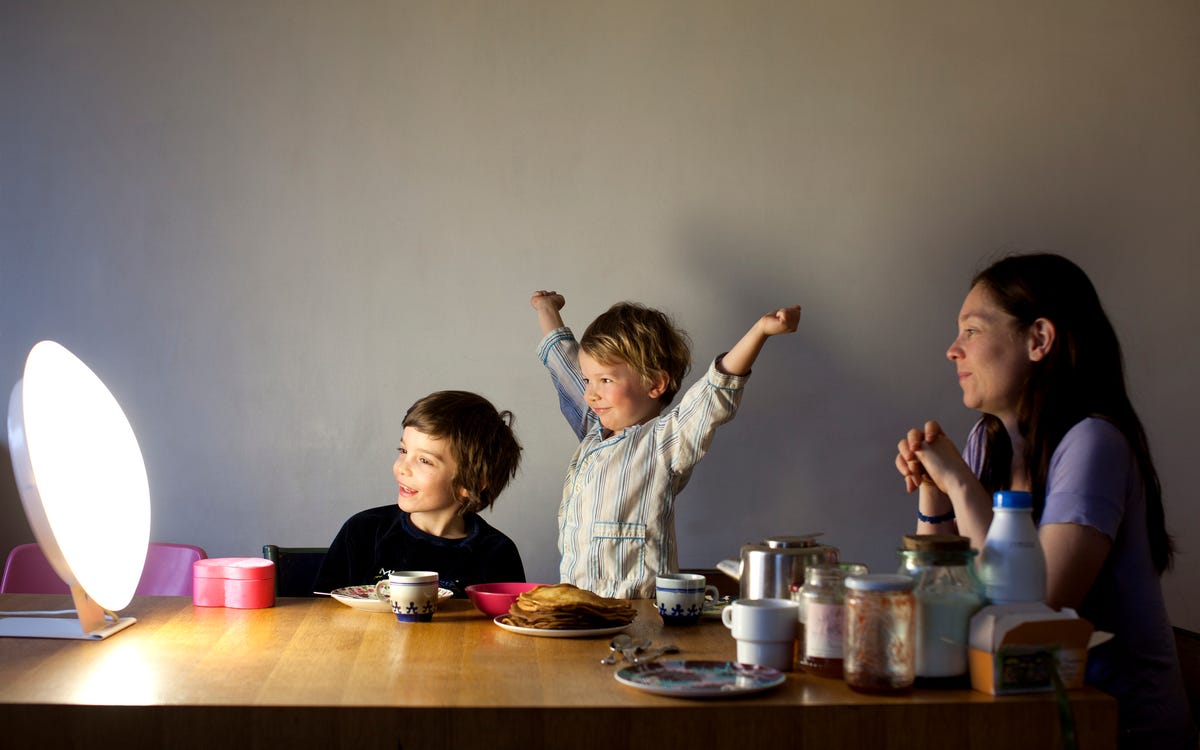We’re in that seasonal transition again where the days end earlier, night comes sooner and we run out of light faster.
It may take several days to adjust to the time change, and many people may feel a little out of whack when first adjusting their routine to the late fall and winter season. However, if you’ve been feeling low most days for multiple winters, it might not just be the winter blues — it could be seasonal affective disorder. The American Association of Family Physicians estimates that 4% to 6% of the population is affected by seasonal depression, with another 10% to 20% experiencing mild effects without seeking treatment.
When you’re feeling particularly low during the colder and darker months, there are steps to take to boost your mood. Light therapy is one of these options.
Read more: 4 Ways to Prepare for the End of Daylight Savings
What is seasonal affective disorder?
SAD is a disorder predominant during certain months (most commonly during fall and winter) and may ease with the change of seasons. In rare cases, people may experience SAD during the spring and summer and symptoms resolve during the fall and winter. Some people experience a combination of symptoms like lethargy, low mood, lack of interest in things they usually enjoy, weight gain and hypersomnia. Common SAD treatments include medication, psychotherapy and phototherapy (light therapy).
Seasonal affective disorder symptoms
Seasonal affective disorder will look different depending on your unique expression of it. The common symptoms mentioned in the Diagnostic and Statistical Manual of Mental Disorders, aka DSM-5 — where it’s referred to as a major depressive disorder with seasonal pattern — include the following:
- Feelings of sadness.
- Sleeping more than usual.
- Feeling tired or unusually fatigued in spite of adequate sleep.
- Feelings of worthlessness or guilt.
- Craving carbohydrates or otherwise changing one’s typical appetite.
- Loss of interest in activities.
- Difficulty with thought, decision-making and concentration tasks.
- In severe cases, thoughts of suicide or death.
Why do some people get SAD?
While there isn’t a known cause for SAD, women are four times as likely as men to experience SAD. A family history increases one’s likelihood to have it, as does having past major depression or bipolar disorder. It’s considered correlated with living far north or far south, where winter months have much less sunlight, and with overall not having a high enough level of vitamin D, which is produced in the skin during sunlight exposure.

What is light therapy?
Because getting adequate sunlight and vitamin D appear to reduce the prevalence of seasonal affective disorder, a variety of specialty lamps have been introduced into the market to provide this light. Sun lamps, also known as “happy lamps,” provide light therapy by offering around 10,000 lux (a unit of light) of light with most, if not all, of the UV radiation filtered out. Light therapy involves sitting or standing in the direct light for around 20 to 30 minutes each day. Different colored filters are also considered helpful, in addition to typical white-light lamps.
Types of light therapy
While many SAD lamps offer full-spectrum visible light, which appears white, other people have studied the effect of different colors of light on seasonal affective disorder.
Blue light therapy
A double-blind study suggests that the blue wavelength of visible light accounts for much of the benefit derived from bright light therapy for depression and low mood.
Red light therapy
While red light therapy is known to benefit one’s skin, it generally didn’t show the same researched benefits for seasonal affective disorder that blue and green light therapy has shown. In some studies, the red light has been associated with better sleep, so if sleeplessness is part of your SAD symptoms, red light may be an option for.
Green light therapy
A study directly contrasting green-hued light therapy with red light therapy found green to be more effective. However, because sample sizes are often small for these types of studie, it may be helpful to consult your doctor to find the best light hue for you.

Benefits of light therapy
Getting a bit more sunlight-like light in your days may be good for your mood. If you have seasonal affective disorder, here are some ways that light therapy can help.
Effective treatment for SAD symptoms
The theory behind light therapy is that vitamin D and sunlight stimulate serotonin production, and serotonin is an important neurotransmitter that impacts mood. Getting more light exposure is thought to have a positive impact on your mood regulation. Light therapy is linked to short-term relief — meaning that it may be effective at relieving symptoms when they occur, but it won’t prevent you from getting SAD in the long run.
Improves depression symptoms
Individuals who have used light therapy report a lessening of depression symptoms when they take a symptom inventory compared to individuals who receive no intervention or a different light intervention, so much so that it has been used in non-seasonal depression cases as well.
Helps aid sleep
Just as blue light has been seen to be energizing and therefore not great for right before bedtime, red light has been seen to have a more calming, sleep-encouraging impact. If part of your seasonal affective disorder symptoms involves a struggle to fall asleep, using a red light lamp could be helpful during the time before sleep to help transition from wakefulness.
Potential risks of light therapy
Even though light boxes and the use of light therapy is considered to be generally safe, it’s best to talk to your health care provider to ensure this is the right option for you and minimize potential drawbacks. Potential side effects of using a light box include:
- Headaches.
- Irritability.
- Eye strain.
- Nausea.
- Induced manic symptoms (if you have bipolar disorder and increase light exposure too fast).
Read more: How the Time Change Affects Your Driving: Tips for Seeing Better at Night
How to use light therapy for seasonal affective disorder
1. Talk with your doctor or mental health professional. They will know if there are any elements of your unique medical profile that would recommend caution with a light therapy lamp.
2. If you are told that light therapy could be a good fit, consider borrowing a lamp first if this option is available to you. If you can find a lamp with multiple color filters, you can use them to evaluate what kind of light therapy works best for you.
3. Begin your light therapy with a white light lamp that emits 10,000 lux and no UV radiation. Put the lamp to your side and at least a foot away from your body, and observe any other instructions in your particular lamp’s operating guidance.
4. Consider a 30-minute session in the morning, or spread a few minutes with the lamp throughout your day. Keeping a daily thought journal and evaluation of your mood can help you see if and how your light use is helping.
5. If you’re under the care of a psychiatrist or mental health counselor, talk with them about the benefits you’ve received from the light therapy. They may have other suggestions for combining it with other seasonal affective disorder treatment.

